Red Lentil Bread Rolls

Ingredients:
| Name | Metric | US | TIP | |
|---|---|---|---|---|
| Dry red lentils, soaked | 185 gr | 1 cup | ||
| Whole psyllium husk | 20 gr | 1/4 cup | ||
| Water | 60 ml | 1/4 cup | ||
| Olive oil | 15 ml | 1 tablespoon | ||
| Baking soda | 3 gr | 1/2 tsp | ||
| Salt | 3 gr | 1/2 tsp | ||
| Apple cider vinegar or lemon juice | 15 ml | 1 tablespoon |
Optional Ingredients :
| 30 gr / 2 tbsp Seed Mix (Sunflower Seeds, Pumpkin Seeds) for topping | |
| 3 gr / 1/2 tsp Garlic Powder | |
| 3 gr / 1/2 tsp Oregano |
Equipment:
| Blender |
Steps:

Step 1

Step 2

Step 3

Step 4

Step 5

Step 6

Step 7
Notes:

Red Lentil Bread Rolls
Soaking lentils before baking bread serves several purposes:
Softening and Hydration: Lentils, especially if they are whole or large, can be quite hard and dry. Soaking them in water helps soften them and hydrate them, making them easier to blend into a smooth paste or incorporate into dough without affecting the texture of the bread.
Reducing Cooking Time: Lentils that have been soaked cook faster. In the context of bread baking, this means that once incorporated into the dough, they will bake evenly and contribute to the overall texture of the bread more effectively.
Improving Digestibility: Soaking lentils can help reduce their phytic acid content. Phytic acid is an anti-nutrient that can bind to minerals like iron, zinc, and calcium, making them less available for absorption. Soaking lentils can help break down some of the phytic acid, improving the digestibility and nutrient absorption of the lentils.
Enhancing Texture: Soaked lentils blend more smoothly into a paste, which helps create a smoother and more cohesive texture in the bread. This improves the overall mouthfeel and consistency of the final product.
In essence, soaking lentils before using them in bread baking helps ensure that they are adequately hydrated, softened, and easier to incorporate into the dough, leading to a better texture and overall quality of the bread.
Red Lentil Bread Rolls additional information:
The nutritional value of bread made with lentils and psyllium husk can be quite beneficial, as both ingredients contribute unique nutritional profiles:
Lentils:
- Protein: Lentils are a good source of plant-based protein, which is essential for muscle repair and overall body function.
- Fiber: Lentils are high in dietary fiber, both soluble and insoluble, which aids in digestion, helps regulate blood sugar levels, and promotes satiety.
- Vitamins and Minerals: Lentils are rich in several vitamins and minerals, including folate, iron, phosphorus, potassium, and manganese.
Psyllium Husk:
- Soluble Fiber: Psyllium husk is extremely rich in soluble fiber, which absorbs water and forms a gel-like substance in the digestive tract. This helps regulate bowel movements, promotes a feeling of fullness, and can aid in lowering cholesterol levels.
- Low in Calories: Psyllium husk is low in calories but high in fiber, making it a beneficial addition to a variety of diets.
- Prebiotic Properties: Psyllium husk can act as a prebiotic, promoting the growth of beneficial bacteria in the gut.
Together, these ingredients in bread form provide a nutritious option:
- Protein: Lentils provide a good amount of protein, essential for muscle growth and repair.
- Fiber: Both lentils and psyllium husk contribute to a high fiber content, which supports digestive health, regulates blood sugar, and promotes satiety.
- Vitamins and Minerals: Lentils add essential vitamins and minerals to the bread, enhancing its overall nutritional profile.
- Low Glycemic Index: The combination of lentils and psyllium husk can contribute to a lower glycemic index of the bread, potentially beneficial for managing blood sugar levels.
Overall, bread made with lentils and psyllium husk can be a nutritious choice, providing protein, fiber, vitamins, and minerals essential for overall health and well-being.
When choosing psyllium husk for baking bread, here are some tips to consider:
Whole Psyllium Husk vs. Psyllium Husk Powder:
- Whole Psyllium Husk: This form consists of intact husks and adds texture and structure to baked goods. It absorbs moisture and helps bind ingredients together. It's ideal if you want to see some texture in your final product.
- Psyllium Husk Powder: This is ground into a finer powder, which disperses more evenly throughout the dough. It still provides binding properties but might result in a smoother texture in the baked bread.
Purity and Quality:
- Look for psyllium husk that is pure and free from additives or fillers. It should be labeled as 100% psyllium husk without additional ingredients.
Color and Freshness:
- Psyllium husk should be light beige to light brown in color. Avoid husk that appears grayish or has a dull color, as this may indicate it's old or lower quality.
Packaging and Storage:
- Choose psyllium husk that is stored in airtight packaging to maintain freshness. Store it in a cool, dry place away from direct sunlight.
Organic vs. Conventional:
- Organic psyllium husk is produced without synthetic pesticides or fertilizers, which some people prefer for health and environmental reasons. It may also have a cleaner taste.
Read Reviews and Recommendations:
- When in doubt, read reviews from other bakers or look for recommendations from reputable sources. This can help you choose a brand or type of psyllium husk that consistently performs well in baking.
By considering these factors, you can choose the right psyllium husk for your bread baking needs, ensuring a successful and delicious result.
Psyllium husk can change the color of your bread, especially if you're using a significant amount of it in the recipe. Here are a few reasons why this might happen:
Natural Color: Psyllium husk is typically light brown to beige in color. When added to dough or batter, especially in larger quantities, it can impart a slightly darker hue to the final baked product.
Reaction with Ingredients: Psyllium husk can react with other ingredients in the bread dough, such as water and acids (if present), which might alter its color during baking. This reaction is usually minor but noticeable.
Concentration: The concentration of psyllium husk used in the recipe can affect how much it affects the color. Higher concentrations or larger amounts can lead to a more pronounced color change.
Browning Effect: During baking, psyllium husk can contribute to the browning process of the bread crust due to its ability to absorb moisture and enhance the Maillard reaction, which gives bread its characteristic brown color.
If you notice a change in color in your bread when using psyllium husk, it's generally nothing to worry about. It's a natural phenomenon and doesn't typically affect the taste or texture negatively. In fact, psyllium husk is valued for its binding properties and nutritional benefits, making it a popular ingredient in gluten-free and low-carb baking.







